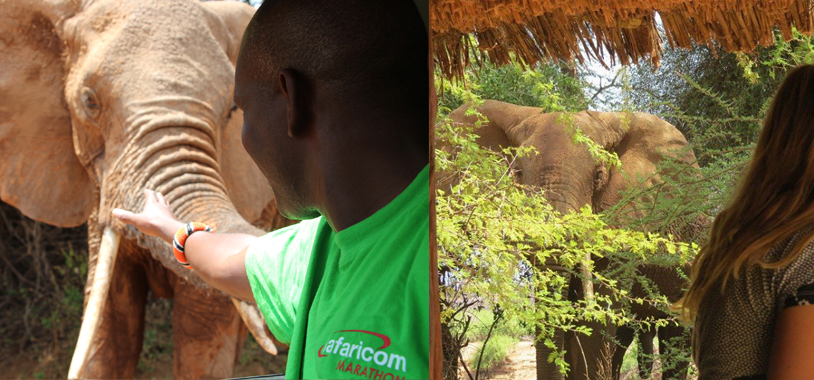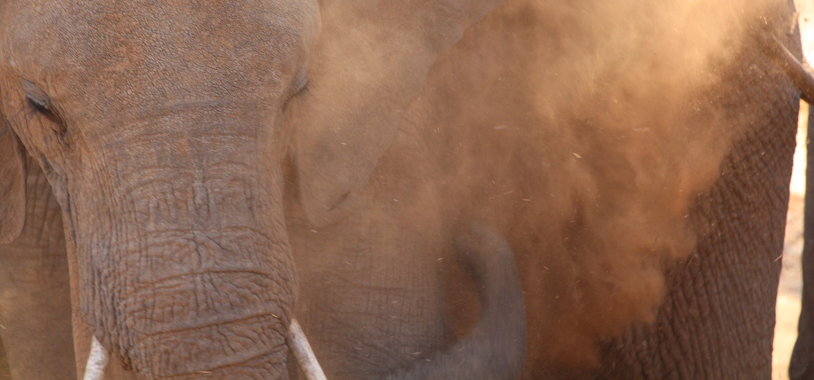Hey! My name is Nina and I’m one of the international interns at STE Samburu camp.
Having grown up in neighbouring Tanzania where I was raised on high doses of sunshine, tropical beaches and frequent, if dusty, safaris, I thought I was prepared for an internship at Save The Elephants. International intern? Pah. I knew what to expect… But from my very first mammal census I realised this wasn’t like anything I’d had the privilege of doing before and beyond my wildest childhood dreams of living amongst the elephants.
The arid plains stretch away from the slow Uaso river, winding its way like an undernourished serpent through the landscape and defining the Eastern boundary of the Samburu reserve. On that first morning drive, Daud confidently manoeuvres the anti-poaching vehicle over the bumpy pathways that define the route ‘Samburu East’, stopping every few meters as we spott, count and record the number of mammals we see. Despite the beauty of the landscape and the abundance of other wildlife, I find my gaze tortuously seeking the large grey shapes of my favourite animals: the elephants. And finally, there they are. Extraordinary in their gentle beauty they stand grazing by the roadside, soft rumbles punctuating the birdsong as they sway through the spiky grass. This first encounter with the elephants of Northern Kenya is barely impressive: seen from a distance of 15 meters away, in the vicinity of several other cars, and on one of the main roads, and Daud seems unimpressed, but I’m mesmerised. I decide there and then that this is a place I can learn to love, and that I will do anything to learn about, protect and conserve these creatures. Idealistic? Yes. True? Also yes.
It takes my first game drive out with Jeronimo to truly understand how amazing the interaction between the researchers and their subjects is here at STE. Jeronimo, once an intern like myself today, is now one of the main researchers in charge of the Long-term Monitoring, or-as everyone in camp knows it-LTM, and he can recognise over 550 individual elephants on sight. Think that’s not such a feat of memory and recognition? Try differentiating between animals that are all roughly the same colour (when they’re not veiled in a thick film of dust or mud) and shape, and, from a distance, all look like rather big, grey rocks… and doing it on the basis of a small nick in one ear, or a slightly longer left tusk.
In the reserve the animals are safe and protected, and so accustomed to vehicles and people that they are generally very calm; simply going about their daily lives as if the big green alien thing inching into their midst was simply another hornbill or dikdik. The car is turned off and we sit, quietly observing the interactions and behaviour of the giants around us. The sounds of the bush and the herd surrounding us is broken only by my camera shutter clicking down to capture yet another magical moment and the explanations from Jeronimo as he explains the behaviour he observes, introduces me to the matriarchs and points out-what seem to me impossibly small-details which he uses to identify the elephants.
I’d be entirely content if all I did was LTM for six weeks, but it seems this is only a tiny part of the adventure. I meet Dr. Iain Douglas-Hamilton and he invites Beth, a fellow intern also from Oxford, and I up for a spotting flight in the hope of locating certain collared elephants. We don’t find them, but do witness the sun sinking down as a fiery ball above the plains. The next day is even better as we manoeuvre five people into the tiny four-seater Cessna, together with three GPS collars and a multitude of other bits and bobs, before taking off and heading North to Sera for a collaring operation. Working in tandem with another small fixed-wing plane, we soar above the chopper acting as spotters for the operation below. The first part of the operation involves herding the elephants out of the newly established rhino reserve and establishing targets for collaring. The dexterity of the pilots is amazing and the first phase of the operation complete, though we find that two young elephants have been separated from their herd. Despite this setback, everyone reconvenes on the ground to prepare for the next stage: collaring. The first elephant to be darted is a female. Circling above with Iain we have a birds-eye view. The elephant is extricated from her herd and slows, wavering until she stops and stands; a tiny swaying silhouette above the red earth. She goes down and the ground team hurtles towards her with water, her collar and the antidote to bring her round. Collar fitted, she’s up again-presumably very disoriented, but well-within 20 minutes of darting. Success. The next collaring is just as efficient and the elephant-a young bull this time-gets up and walks off to resume his life. I am filled with admiration for these remarkable people whose devotion and skill in the field are unparalleled.



